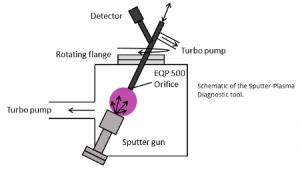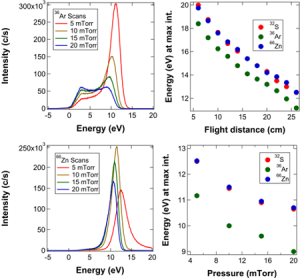![]()
Bio
Daniel Meysing is a Ph.D. candidate in the Chemical and Biological Engineering Department at the Colorado School of Mines in Golden, Colorado. He is advised by Prof. Colin Wolden and Adjunct Prof. Teresa Barnes from CSM. Here, he describes his research.
Research
Our group began working with the Hiden EQP 500 about one year ago. We are investigating the chemistry and energetics in the radio frequency magnetron sputtering of II-VI compounds used in thin-film solar cells. Sputter deposition of these materials is often treated as a “black box” in which we control the input parameters (sputtering power, pressure, ambient composition) and determine the film properties (optical transmission, conductivity, composition) without detailed knowledge of the process itself. Our goal is to develop a better understanding of some of the complex mechanisms in sputtering that affect optoelectronic properties in thin films.

The sputtering chamber, termed the Sputter-Plasma Diagnostic (SPD) tool, accommodates up to six sputtering guns in sputter-up configuration. A rotating flange, on which the Hiden EQP is mounted, and a z-axis motor allow the Hiden EQP 500 analyser to be placed normal to or off-axis to the sputtering target and moved closer to or further away from the target. The EQP is differentially pumped and can be fitted with different diameter orifices so that it can be used over a range of different pressure regimes. We use a 100-µm aperture in the current work to enable analysis at typical sputtering pressures of ~10 mTorr.
Some of our initial work has focused on plasma-generated ion energy distributions (IED) during radio frequency magnetron sputtering of ZnS in a pure Ar ambient. We have probed parameters such as the power, pressure, and flight distance of Ar, Zn, and S ions. Ar ions have distinctly different IEDs compared to Zn and S. The Ar IED has a low-energy shoulder caused by reflection at the target and Penning ionization reactions, whereas Zn and S IEDs have a single dominant peak and often a small high-energy shoulder. In all cases, the Zn and S peaks are ~1.5 eV higher in energy than the Ar peak. The effect of flight distance was investigated by varying the displacement between the target and the EQP orifice. As expected, additional collisions caused the arrival energy of ions to decrease with increasing flight distance. In a similar manner, the ion energy decreased with increasing pressure.

Zinc sulfide ion energy distribution scans. (Top left) 36Ar profiles as a function of pressure; (Bottom left) 66Zn profiles as a function of pressure; (Top right) 32S, 36Ar, and 66Zn IED peak positions as a function of flight distance; (Bottom right) 32S, 36Ar, and 66Zn IED peak positions as a function of pressure.
Future Research
We plan to study oxygen incorporation during reactive sputtering of ZnS and CdS in an O2/Ar ambient. Oxygen is known to incorporate via substitution and/or reaction with sulfur.
Our poster, entitled “Energy-resolved quadrupole mass spectrometry in IIB-VIA sputtering investigations,” won third place at the 2014 Rocky Mountain American Vacuum Society Symposium held in Denver, Colorado. View Poster
References
1) D.M. Meysing, J.M. Burst, W.L. Rance, M.O. Reese, T.M. Barnes, T.A. Gessert, C.A. Wolden, The influence of cadmium sulfide and contact annealing configuration on the properties of high-performance cadmium stannate, Solar Energy Materials and Solar Cells 117 (2013) 300–305.
2) W.L. Rance, J.M. Burst, D.M. Meysing, C.A. Wolden, M.O. Reese, T.A. Gessert, W.K. Metzger, S. Garner, P. Cimo, T.M. Barnes, 14%-efficient flexible CdTe solar cells on ultra-thin glass substrates, Applied Physics Letters 104, (2014) 143903.
Project Summary by:
D.M. Meysing
Colorado School of Mines
1500 Illinois St.
Golden, CO 80401
USA
Visit Product Page : EQP
View Full Newsletter : Mass Spectrometers for Plasma Characterisation
Make an enquiry : Send us a message

